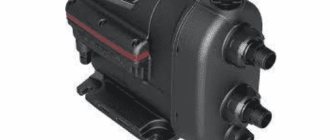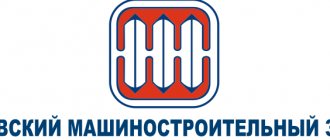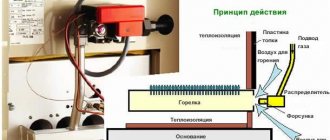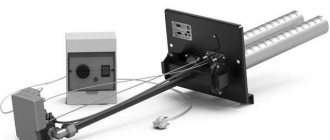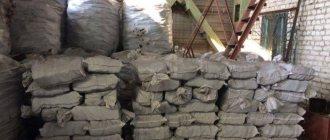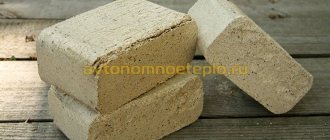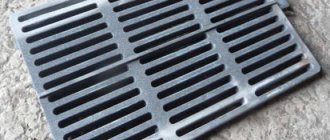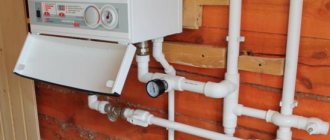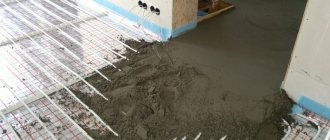Here you will learn:
- Fire wood stoves
- What are fuel briquettes made from?
- Advantages and disadvantages of fuel briquettes
- Popular types of wood briquettes
Despite the widespread construction of gas pipelines, there are still many settlements and places in Russia where there is simply no gas. People have to use alternative heat sources, for example, solid fuel boilers. These units operate on wood, but recently more modern types of fuel have begun to be produced for them - these are fuel briquettes for heating stoves. Let's look at them in more detail and find out their advantages and disadvantages.
In this review we will look at:
- Disadvantages of classic firewood;
- Fuel composition;
- Main types of briquetted fuel;
- Pros and cons of briquettes for the stove.
After reading the review, you will be able to make a choice in favor of traditional firewood or in favor of more modern briquette fuel.
Advantages of wood briquettes
After wood processing, a lot of waste remains.
These are all kinds of sawdust, shavings, bark. Briquettes are produced by pressing, mechanical intervention and heat treatment. Advantages of wood briquettes:
- High calorific value;
- The material is highly flammable and does not require additional drying;
- Heating briquettes do not emit smoke during combustion;
- The characteristics of the material allow for long burning;
- During use, a stable temperature is maintained;
- After combustion, a minimal amount of waste remains;
- Compactness;
- Low price;
- Wood briquettes can replace other types of fuel.
Wood briquettes are universal for any firebox. They can be used for stoves, boilers, barbecues. Due to its small size, the material is easy to transport. You can take a bunch of briquettes with you on a picnic.
Wood briquettes are widely used abroad. Often this fuel is used to heat a fireplace or boiler at home. There are special fireplaces for briquettes.
Coal for a good boiler
The combustion temperature of hard coal can reach 1400o C, the ignition temperature is 600o C - these properties are used when conducting energy-intensive processes in ferrous and non-ferrous metallurgy, where hard coal and anthracite are traditionally used. The combustion of coal (brown) is accompanied by increased heat transfer to heat metals up to 1200o C. At the same time, studies show that when coal burns, up to 40% of volatile gases are released, and after their combustion, up to 14% of ash remains.
Coal briquettes for heating have significantly lower values for these indicators, while maintaining high combustion heat characteristics (up to 5500 kcal). Briquette is a compressed mixture of crushed coal fractions and fixative fillers with a density of 1.4 g/cm3. High calorific value and the absence of coal dust have made coal in briquettes a popular type of fuel used in private households and in enterprises where there is no centralized heat supply. Coal slag, formed during the combustion of fuel, can serve as fertilizer for plants in the area adjacent to the house.
Popular types of wood briquettes
We have already talked about the production of fuel briquettes for heating boilers and furnaces, as well as their key advantages and disadvantages. It remains to figure out what types of briquettes are presented on the domestic market.
Fuel briquettes RUF
This fuel resembles white or wood-colored bricks in appearance (the shade varies widely). RUF briquettes are made from dry sawdust by pressing under high pressure. As a result, Euro-firewood is born, which can be used in any type of stove. Their distinctive feature is the inscription RUF, embossed on both sides.
RUF fuel briquettes for heating stoves are characterized by the release of a large amount of heat - they are almost one and a half times more profitable than firewood. They are easy to load combustion chambers and store them in stacks. Pressed bars are not afraid of moisture, but there is also no need to expose them to direct water. This fuel is supplied by many manufacturers - a typical example is. By the way, it also sells many other types of solid fuel.
Eurobriquettes PINI KAY
An interesting feature of these Eurobriquettes is their unusual shape - they resemble square pencils from which someone has taken the lead. That's why they are called "pencils". In order for it to burn with the release of a large amount of heat, a hole is made in it, increasing the draft. The “pencils” themselves look dark, as they were fired. This procedure makes them more durable and removes excess moisture.
The disadvantage of PINI KAY fuel briquettes for heating stoves is that they are more expensive than firewood and even more expensive than any other types of fuel. But they burn well, releasing a large amount of heat. They are also convenient to transport and store. Thanks to their shape, they are ideal for lighting fireplaces. Some people take them with them into the wild to use PINI KAY bars instead of wood for a fire.
Simple cylindrical briquettes
The simplest fuel briquettes for heating stoves are also on sale - in the form of cylinders. They are made from pressed sawdust and small wood waste. All this is pressed under slight pressure using a non-toxic adhesive base, after which the finished bars are sent to consumers. This fuel is cheap, but has one distinct drawback - low strength. It easily disintegrates and crumbles and does not withstand exposure to moisture.
Fuel briquettes from coal and peat
Peat and coal fuel briquettes for heating stoves are made from peat and coal, respectively. The starting materials are formed into small cylinders. The fuel can be used to light stoves and solid fuel boilers. Coal products give a high combustion temperature, but are characterized by high ash content. As for peat fuel, it is ideally suited for long-burning stoves, but it also produces a lot of ash.
Manufacturing technology and scope
After processing natural raw materials, a large amount of waste remains. For example, in the woodworking industry these are shavings, sawdust, and wood chips. Each production strives for a waste-free operation scheme, so they have long learned to use even leftover raw materials to make the necessary products, for example, chipboard. With the rise in price of solid fuels, waste began to be pressed into briquettes that were convenient for use and transportation - and they immediately became in demand.
The technology for making wood briquettes for heating is simple: the waste is crushed, pressed, and simultaneously subjected to heat treatment. To bind particles together, the natural component lignin or synthetic solutions are used. Lightly melt the surface to maintain its shape.
To increase combustion efficiency, some types have through holes. Then small-sized products are packaged in film or paper bags; more protected briquettes are left unpacked. In this form, the products are sold for private and industrial needs.
When purchasing briquettes at retail or, which is much more profitable, wholesale, pay attention to the shape and size - they must match your boiler, stove or barbecue
The heat transfer of the fuel is sufficient for it to be successfully used for heating completely different rooms, such as:
- production workshops, warehouses with an area of up to 200 m²;
- utility rooms, boiler rooms;
- private properties: cottages, country houses, dachas;
- Russian baths, saunas.
Small-sized briquettes and granules can easily be placed in stoves of any size; for volumetric solid fuel boilers, “eurowood” of increased length or diameter is provided. One example: 30-35 kg of sawdust fuel is needed per day to heat a large warehouse hangar with an area of 180-200 m², that is, 3-3.5 standard ten-kilogram packages will be needed.
Light and compact briquettes are convenient for transportation in the trunk of a car, they burn well in the open air, so lovers of outdoor recreation prefer to take them with them for making fires, barbecuing or cooking on the grill. For summer residents, briquetted products are a universal means - they are successfully used both for heating houses and for starting a fire on the site.
Comparison of briquettes with conventional solid fuel
The cost of coal, firewood or pressed sawdust used for heating varies depending on the region. Therefore, there is no clear decision on the choice of one type of fuel or another.
It is necessary to take into account the current price and conduct an analysis of comparative characteristics
Specific calorific value
One of the main indicators of fuel efficiency is its specific calorific value (specific heat of combustion). This parameter determines how much mass fraction of a substance, when burned, will be required to release a certain amount of energy.
Comparative calorific value of various types of fuel. The values given are approximate and depend on many factors. But in general, the table shows the rating of solid fuels by specific calorific valueThere is one nuance here: calorific value depends on mass, and firewood and sawdust briquettes are usually measured in cubes. When advertising compressed fuel, they often indicate that the energy output is almost twice as high as when burning wood, but they do not indicate the fact that the weight of dry briquettes per cubic meter is greater.
Let’s assume that the calorific value of freshly cut birch is about 2 kcal/kg, and that of briquettes is 4 kcal/kg. The weight of a folded cube of firewood is about 570 kg/m3, and the weight of the same volume of pressed material is about 800 kg. Therefore, a cubic meter of raw chopped wood when burned will give about 1.14 mCal, and briquettes - about 3.2 mCal, that is, almost three times more.
The thermal efficiency of industrially produced briquettes can be compared with charcoal or coal, but the latter is much cheaper.
Storage and ease of use
One of the disadvantages of pressed raw materials is its high hygroscopicity. The intense ability to absorb moisture leads to a loss of rigidity between the bound particles and possible crumbling of the briquette. Therefore, unlike coal or firewood, sawdust must be stored in a dry place.
Fuel briquettes can also be kept indoors. Industrially produced pressed raw materials practically do not produce waste, unlike the same firewood.
Due to the dirt and dust created, coal and firewood are stored outside. Neat briquettes made from shavings can be kept in the veranda of your home
Pressed wood requires a minimal amount of ignition material to start burning. Here sawdust, like peat, has no competition.
Application in long-burning boilers
Nowadays, long-burning boilers are deservedly popular, especially among cottage owners. They are economical, have high efficiency and are easy to operate. Their only significant disadvantage is the cost of the equipment and the costs of its installation.
Many advanced boiler models are equipped with an automated fuel loading system. For its operation, it is necessary to use a combustible material of uniform shape. For this purpose, pellets are made from sawdust and shavings.
Pellets are made from wood waste by pressing. They have the form of granules with a diameter of 6-9 mm and a length from 10 to 70 mm
The use of this type of fuel in such boilers allows maintaining the required temperature without human intervention. This allows cottage owners to be away for a long period (up to several days) without the risk of the home cooling to unacceptable levels.
Wood from birch sawdust: easy production
It is difficult to imagine that wood briquettes, which, unlike firewood, have increased calorific value and can maintain combustion for up to one and a half hours, can be made from sawdust, shavings and other wood waste and plant waste by processing by pressing and extrusion. Additional heating to a temperature of 250-350o C ensures increased product density, reduced humidity (up to 5.6%) and, accordingly, prolonged combustion and high heat transfer.
The production of briquettes from sawdust and plant waste is an effective way to create environmentally friendly fuel for stoves, fireplaces and solid fuel boilers used for heating residential buildings and industrial premises. This type of fuel is characterized by the absence of smoke, ash, and volatile gases that accompany the combustion of coal and wood.
In accordance with the technologies for the production of solid fuel from wood and plant waste, a machine for making briquettes from sawdust (briquetting press or extruder) is the main component of a complex of special equipment, including:
- shredders for wood and plant raw materials supplied for processing;
- drying equipment;
- conveyors designed for supplying raw materials and shipping products for storage and sale.
Charcoal briquetting
When producing charcoal, about a quarter of it turns out to be substandard - small pieces and dust. To turn this waste into income, you can make briquettes from them. Charcoal briquettes can also be made at home; if necessary, you can make raw materials for this (charcoal yourself). The principle of briquetting charcoal is no different from the formation of the same fuel from coal:
- Substandard coal is crushed.
- Mix with binder. In this case, a regular starch paste will do the job well. The output should be a slightly moist mass. Some of the dust rolls into small lumps.
- The resulting mixture is fed into a press, where briquettes are formed.
This video clearly shows the entire technology of charcoal briquetting, but the guys created a form specifically for the customer (church tablets made from charcoal for incense were ordered). Similarly, you can make a mold of any configuration.
Conclusions. Briquettes from coal crumbs and dust (stone and wood) can be made at home. It is difficult to achieve commercial results (only through automation, and therefore expensive equipment), but for home use it is possible to make a simple installation.
Features of wood burning
To ensure high-quality heating, you need to know how to heat a solid fuel boiler with wood efficiently and economically. For kindling, chips are laid down, on top of which you need to place 3-5 firewood with a diameter of up to 15 cm. It is recommended to lay crumpled paper between the chips so that the wood flares up faster.
After the first fire has ignited, the firebox is filled with large firewood. To achieve the most complete and efficient burning of wood, you can place 1-2 large logs in the firebox at intervals of 30-40 minutes. In addition, this method will help reduce firewood consumption.
When the firebox is completely filled with large firewood, an ordinary modern solid fuel boiler is capable of maintaining fairly intense combustion for 3-4 hours. Long-burning boilers operate on one burner even longer. It is generally not recommended to burn such models with small wood, which does not burn completely due to increased gas emission. The optimal size of logs in diameter is 15-30 cm.
If you figure out how to properly heat a TT boiler, then the choice of firewood is of great importance. Wood moisture content should not be higher than 20%, otherwise the efficiency of the equipment will be lost. In some cases, to increase the burning time, damp wood is specially placed in the firebox, which takes longer to burn. However, it must be taken into account that this leads to increased release of tar, which settles on the walls of the firebox and on the chimney, and this causes deterioration in draft. As a result, the boiler has to be cleaned more often. In order for firewood to have an optimal level of humidity, it must be dried under a canopy for approximately 1.5-2 years before use.
If you want to increase the burning time of one bookmark, then you should not use damp firewood, but set the correct position of the gate valve and thermostat. These provisions for each TT boiler model are determined experimentally.
Comparative characteristics of briquettes
| Type of fuel | Calorific value, MJ/kg |
| Anthracite | 26,8-31,4 |
| Brown coal | 10,5-15,7 |
| Coal | 20,9-30,1 |
| Gas | 27 |
| Peat (humidity 20%) | 15,1 |
| Diesel fuel | 42,7 |
| Wood (humidity 40%) | 6-11 |
| Briquettes (from sawdust) | 16-29,5 |
Each type of briquettes has its own characteristics and advantages. And although all of them are excellent for heating in domestic conditions, it is still worth familiarizing yourself with their characteristics in more detail in order to choose the best option.
Forms of fuel briquettes
Wood briquettes
This type of briquettes is obtained by pressing various wood waste - dead wood, sawdust, shavings, substandard wood. Before pressing, the waste is heated to a certain temperature, as a result of which an adhesive substance, lignin, is released from the cells. Thanks to lignin, briquettes acquire high strength and retain their shape during transportation and storage.
Wood briquettes
The advantages of briquettes over solid wood are obvious:
- the density of briquettes is constant and amounts to 1240 kg/m³, the density of wood depends on the species and ranges from 150-1280 kg/m³;
- maximum humidity of briquettes is 10%, wood – from 20 to 60%;
- when burning a briquette, the volume of ash is 1% of the total mass, wood - 5%;
- when burning, a briquette emits 4400 kcal/kg, wood - 2930 kcal/kg.
In addition, wood briquettes have other advantages:
- pressed wood does not spark when burning and emits very little smoke;
- a constant temperature is maintained in the boiler;
- briquette burning time 4 hours;
- the coals remaining after combustion are excellent for cooking over an open fire;
- the correct shape of the briquettes simplifies their transportation and storage.
Such fuel is sold not in cubic meters, like wood, but in kilograms, which is much more profitable.
Prices for Eurofirewood Briquettes
Eurofirewood Pini-kay
Coal briquettes
Coal briquettes
This type of briquettes is obtained from screening out coal. First, the screenings are crushed, mixed with a binder, and then compressed under high pressure.
The main properties of such fuel:
- coal briquettes do not smoke;
- do not emit carbon monoxide;
- burning time in conventional boilers is from 5 to 7 hours, with controlled air supply – 10 hours;
- suitable for use in domestic conditions;
- have a compact shape;
- when burning they release 5200k/cal and maintain a constant temperature;
- maximum ash volume – 28%;
- have a long shelf life.
Coal briquettes are the most optimal fuel in harsh winters, when pressure drops in domestic gas systems due to low temperatures. Briquettes burn at any temperature, the main thing is that there is a constant flow of air.
Prices for WEBER coal briquettes
WEBER coal briquettes
Peat briquettes
Peat briquettes
To make briquettes, peat is dried, heated and pressed under high pressure. The result is neat, light, dark-colored bricks. With an adjustable air supply, peat briquettes maintain the temperature for 10 hours, which is very convenient for heating the house at night.
Basic properties:
- suitable for all types of ovens;
- heat transfer is 5500-5700 kcal/kg;
- ash volume 1% of the total volume of the briquette;
- affordable price;
- minimum amount of impurities in the composition.
The ash that remains after fuel combustion can be used as an effective lime and phosphate fertilizer. For many owners of private households, this factor is decisive when choosing heating briquettes. Since peat is a flammable substance, it should be stored at a safe distance from open fire and heating devices. Even dust spilled from the packaging can ignite and cause a fire, so briquettes must be handled correctly.
Husk briquettes
Husk briquettes
Sunflower husks, buckwheat and rice husks, rye waste, oats and even straw are widely used to make fuel briquettes. The most common are briquettes made from sunflower husks, since the production of oil leaves a large percentage of waste. The maximum moisture content of husks for pressing is 8%, which increases heat transfer and reduces combustion time.
Sunflower briquettes
Specifications:
- briquette density is 1.2 t/m³;
- heat transfer – 5200 kcal/kg;
- ash volume from 2.7 to 4.5%.
Additional benefits:
- absence of harmful impurities;
- affordable price;
- long burning time;
- ease of storage and transportation.
From the husks
The briquetting system for various types of fuel also includes the production of briquettes from sunflower husks and small agricultural waste. Until recently, husks were used for heating private houses, mainly as a means of kindling - small particles burn quickly, bringing virtually no heat. Unlike unprocessed raw materials, pressed husk fuel is a valuable fuel with a high calorific value (up to 5900 kcal/kg), which is widely used for heating residential and industrial premises. For comparison: the amount of thermal energy released during the combustion of 1 ton of husk briquettes is equivalent to the combustion energy of 500 liters of diesel fuel or 1.6 tons of firewood. Minerals. The minerals contained in the husk ash are beneficial for plants and are used in fertilizers.
Varieties
Fuel briquettes differ in the material that is the main one in their production and the technology underlying their production.
The raw materials for fuel briquettes are:
- various wood of all species - shavings, sawdust, branches;
- dust and fine fraction of hard and brown coals;
- agro-industrial waste - straw, sunflower husks, buckwheat, rice;
- peat.
Let's consider the main technical characteristics of fuel briquettes made from various raw materials.
| View | Heat transfer, kW/kg | Humidity, % | Ash content, % | Approximate price for 1 ton, c.u. |
| Wood briquettes | 5,2-5,8 | up to 12 | 1 | 102 |
| Coal briquettes | 7,55 | 10-15 | 12 | 150 |
| Brown coal briquettes | up to 5 | 10-15 | up to 30 | 70 |
| Eurofirewood made from sunflower husks | 4,5-5 | 10 | 5 | 79 |
| Straw briquettes | 4,8-5,2 | 10 | 4 | 65 |
| Peat briquettes | up to 4.5 | before 18 | 20 | 90 |
Fuel briquettes should be stored in a well-ventilated area where there is no free access to moisture. In the summer, briquettes cannot be stored on the ground without being separated by a film from below from evaporation from the soil, since moisture condenses on the packs of briquettes at night. Therefore, on the bottom of the pallet under the packs it is necessary to arrange a hermetically sealed insulation from the ground, for example, you can use plastic film.
You can read about the features of fuel briquettes from manufacturers Ruf, Pini Kay, Nestro and Nilson here.
Simple cylindrical briquettes
This is the most common type of fuel briquettes, made in the form of cylinders. Sawdust and small wood waste are used as manufacturing materials. All this is pressed under low pressure using a non-toxic adhesive base. After this process is completed, the finished briquettes are put up for sale. Such fuel is inexpensive, but cannot boast of high strength. They tolerate moisture very poorly, crumble and fall apart.
Sunflower fuel briquettes
Fuel briquettes from coal and peat
Based on the name, it becomes obvious that coal and peat are used to create such fuel briquettes. Coal and peat briquettes are used for lighting stoves and solid fuel boilers. Fuel made from coal has a high combustion temperature, but it also produces a large amount of ash.
Fuel briquettes from coal
Classification of briquetted products
The division into groups takes into account various criteria: material of manufacture, product shape, degree of protection, degree of environmental friendliness, even type of packaging. Let's consider one of the common classifications - by type of manufacture and shape.
Most briquettes are products of a certain configuration:
- RUF - bricks with rounded corners.
- Nestro - cylinders of various lengths.
- Pini-kay - elongated polyhedrons with a hole in the middle.
The first rectangular RUF products appeared in Germany. To produce them, powerful hydraulic presses are used, operating under pressure up to 400 bar. The cylindrical shape is produced on machines with hydraulics or a shock-mechanical drive; some “barrels” have a radial hole.
RUF briquettes are chosen for their compactness, low cost and ease of use. They continue to generate heat even in the absence of open fire
To produce pini-kei tubes, in addition to the standard mechanical pressing procedure under pressure up to 1100 bar, thermal firing is used. It increases strength, moisture resistance, calorie content and prolongs the burning period. Products from the first two groups, on the contrary, are fragile and easily absorb moisture, so they are always packaged in airtight containers that are easy to transport. Long cylinders and tubes (60-70 cm) can be easily divided into parts if desired.
The quality of processing of fuel briquettes also affects their cost - pini-kei is more expensive than the other two analogues. They can be recognized by their characteristic black or dark brown exterior. The material of manufacture and characteristics are usually indicated on the packaging.
Along with fuel briquettes, pellets are used - small granules. They have high heat transfer due to their high carbon content and dense structure
Fuel briquettes are classified as environmentally friendly fuels for several reasons:
- For production, only waste that can be recycled is used - dust, crumbs, sawdust;
- when burning briquetted fuel, a minimum of carbon dioxide is released (for comparison, the combustion of natural gas increases the volume of carbon dioxide released by 10 times, coal - by 50 times);
- As a result of combustion, ash (not coal) is formed, which is suitable for feeding garden crops as a nitrogen fertilizer.
Heating cottages and country houses with briquettes is safe and efficient.
However, the most convenient classification is recognized according to the material of manufacture, that is, the remains of natural raw materials - agricultural biomass, coal dust, sawdust, peat chips, etc. We will dwell on it in more detail.
Types of fuel briquettes:
1. According to production method:
— cylinder briquettes (“Nestro”, length 50–350 mm, diameter 60–90 mm)
When choosing such briquettes, pay attention to their dimensions: the length of high-quality briquettes is at least 250 mm, and the diameter is 80 mm. This type of briquettes is produced from crushed raw materials using mechanical or hydraulic presses that create high pressure. Briquettes with a radial hole burn better
— briquettes-bricks (“ruf”) are made from woodworking waste under a hydraulic press. An important point: do not buy products whose raw materials are plywood waste. They contain formaldehyde and other resins that will release these substances when burned. Otherwise, the quality of briquettes does not depend on the equipment on which they are produced.
— polyhedron briquettes with holes (“pini-kay”). Of all types of fuel briquettes, pini-kay has the greatest heat generation capacity. Thanks to annealing at the final stage of pressing (which gives them a dark color), these briquettes become moisture-resistant and durable. They are great for fireplaces because... burn beautifully. But their cost is higher than that of other types of briquettes.
2. By type of raw materials used:
— agricultural waste: straw, sunflower husks, buckwheat husks, etc. They have high heat transfer (5200 Kcal/kg) and low cost. This is the cheapest type of compressed fuel. A small minus is that after combustion, 3-4.5% of ash remains from the initial volume.
- wood processing waste. The heat transfer of briquettes from such raw materials depends on the compaction density: the higher the density, the higher the heat transfer. Burning time is about 4 hours, the amount of smoke is minimal. Ash residue - 1%.
- peat. Advantages: combustion up to 10 hours, high heat transfer (up to 5700 Kcal/kg). Disadvantages: strong smoke, large ash residue, dangerous impurities in the composition. Peat briquettes are not recommended for heating your home.
— coal screenings with a binder composition. Burning time - 6-10 hours, high heat transfer (5200 Kcal/kg), ash residue - 28%. The downside is that when burned, substances hazardous to health are released.
You can make fuel briquettes yourself at home from biomass and waste paper. Maxim Soroka from the National Environmental Center of Ukraine talks about this in more detail.
And Ukrainian Nikolai Kikot grows his “fuel” in the form of giant miscanthus reed. When burning 2 kg of this plant, the same amount of heat is released as when burning 1 kg of coal.
Pros and cons of using a bathhouse for heating
When burning, Eurowood does not produce sparks.
They produce less debris, ash and soot. Fuel briquettes are convenient to store. Standard sizes and shapes allow for easy stacking. This is an environmentally friendly material for human health.
Compared to conventional firewood, they emit 2-3 times more heat and burn 1.5-2 times longer. When using fuel briquettes to heat a bathhouse, you will have to clean the chimney less often. The disadvantages of the products include their high cost and fear of moisture. They must be stored in dry rooms. They will crumble under the influence of precipitation outside.
